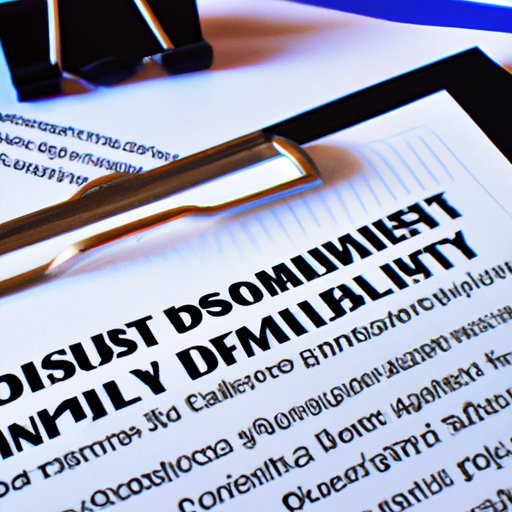
I. Introduction
Applying for disability benefits can be a complicated and overwhelming process. For those who are disabled and in need of financial assistance, it can be difficult to know where to start. This article aims to provide a comprehensive guide to filing for disability benefits and understanding the application process and appeals.
II. Overview of the Disability Filing Process: A Step-by-Step Guide
The process of filing for disability benefits can be broken down into several steps. Here is a step-by-step guide to help you navigate the application process:
- Determine if you are eligible for disability benefits.
- Apply for benefits by completing the necessary application forms.
- Submit your application and supporting documents to the Social Security Administration (SSA).
- Wait for the SSA to review your application and make a decision.
- If approved, begin receiving disability benefits. If denied, consider appealing the decision.
III. Understanding the Disability Benefits Application: Tips and Tricks
The disability benefits application can be complex, but there are several tips and tricks to make the process easier:
- Be honest and accurate when filling out the application.
- Provide as much detail as possible about your disability and how it affects your daily life.
- Include all relevant medical information and documentation.
It is important to avoid common mistakes when submitting your application:
- Leaving out important information or documentation.
- Submitting incomplete or inaccurate information.
- Missing deadlines or submitting after the deadline.
IV. Important Documents Needed to File for Disability
There are several important documents that you will need to include with your disability benefits application:
- Proof of identity (birth certificate, passport, driver’s license)
- Proof of citizenship or legal residency status (green card, naturalization certificate)
- Medical records and doctor’s reports
- Employment history and tax returns
To make the process easier, be sure to gather all of these documents before submitting your application.
V. How to Prove Your Disability: Information and Evidence to Provide
Proving that you are disabled and eligible for benefits requires specific information and evidence. Be sure to include:
- Diagnostic tests and medical records from doctors, hospitals, clinics, and other medical professionals who have treated your disability
- A list of medication, treatment, and surgery that you’ve received due to the disability
- Any statements from others that can verify your disability
- Relevant documents from government agencies, such as the VA, which confirm that you received benefits due to a disability rating
VI. Common Mistakes to Avoid When Filing for Disability Benefits
In addition to submitting incomplete or inaccurate information, there are other common mistakes to avoid when applying for disability:
- Failing to get a doctor’s opinion in writing that you’re disabled
- Failing to show how your disability limits certain movement and ability to function
- Ignoring the instructions of the agency and associating yourself with the wrong legal form
- Failing to understand the requirements to qualify for disability benefits
These mistakes can cause delays or even prevent you from receiving benefits altogether.
VII. Appealing a Denied Disability Claim: Next Steps to Take
If your disability benefits application is denied, you have the option to appeal the decision. To do so:
- Contact the SSA within 60 days from receiving the denial notice and then ask for reconsideration.
- If you fail the reconsideration, you have another 60 days to appeal again and request a hearing with a judge
- Prominently provide additional evidence concerning your medical records that demonstrate your disability.
- Keep in mind there are time limits to your requests, so don’t wait to appeal the decision in writing.
VIII. The Dos and Don’ts When Filing for Disability Benefits
To maximize your chances of receiving disability benefits, follow these dos and don’ts:
- DO be honest and accurate on your application.
- DO be specific about your disability and how it affects your daily life.
- DO include all relevant medical information and documentation.
- DON’T leave out important information or documentation.
- DON’T submit incomplete or inaccurate information.
- DON’T forget to gather all necessary documents before submitting your application.
IX. Conclusion
Filing for disability benefits can be challenging, but with this guide, you can gain a better understanding of the application process and increase your chances of receiving benefits. Remember to provide accurate and complete information, include all necessary documents, and avoid common mistakes. If your claim is denied, don’t hesitate to appeal the decision. Finally, remain positive and don’t get discouraged if your application is not approved initially. Sometimes with the help of a successful SSA attorney, you have a better chance to appeal. Stay strong, and keep pushing forward.




